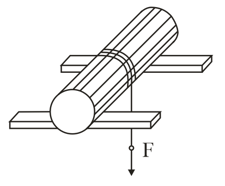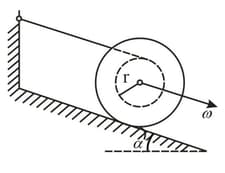A uniform cylinder of radius is spinned about its axis to the angular velocity and then placed in a corner. The coefficient of friction between the corner walls and the cylinder is equal to . How many turns will the cylinder accomplish before it stops?
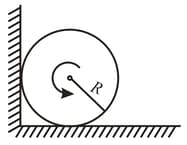

Important Questions on PHYSICAL FUNDAMENTALS OF MECHANICS
A uniform cylinder, of radius and mass , can rotate freely about a stationary horizontal axis . A thin cord, of length and mass , is wound on the cylinder in a single layer. Find the angular acceleration of the cylinder as a function of the length of the hanging part of the cord. The wound part of the cord is supposed to have its centre of gravity on the cylinder axis.
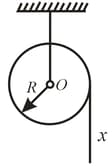
the magnitudes of the friction coefficient, at which slipping is absent;
the kinetic energy of the sphere, after the beginning of motion.
A uniform cylinder of mass , and radius , starts descending, at a moment , due to gravity. Neglecting the mass of the thread, find:
the tension of each thread and the angular acceleration of the cylinder;
the time dependence of the instantaneous power developed by the gravitational force.
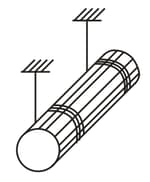
Thin threads are tightly wound on the ends of a uniform solid cylinder, of mass . The free ends of the threads are attached to the ceiling of an elevator car. The car starts going up with an acceleration . Find the acceleration , of the cylinder, relative to the car, and the force , exerted by the cylinder on the ceiling (through the threads).
A spool, with a thread wound on it, is placed on an inclined smooth plane, set at an angle , to the horizontal. The free end of the thread is attached to the wall, as shown in the figure. The mass of the spool is , its moment of inertia, relative to its own axis, is and the radius of the wound thread layer is . Find the acceleration of the spool axis.
A uniform solid cylinder of mass , rests on two horizontal planks. A thread is wound on the cylinder. The hanging end of the thread is pulled vertically down, with a constant force . Find the maximum magnitude of the force , which still does not bring about any sliding of the cylinder, if the coefficient of friction between the cylinder and the planks is equal to . What is the acceleration , of the axis of the cylinder, rolling down the inclined plane?
